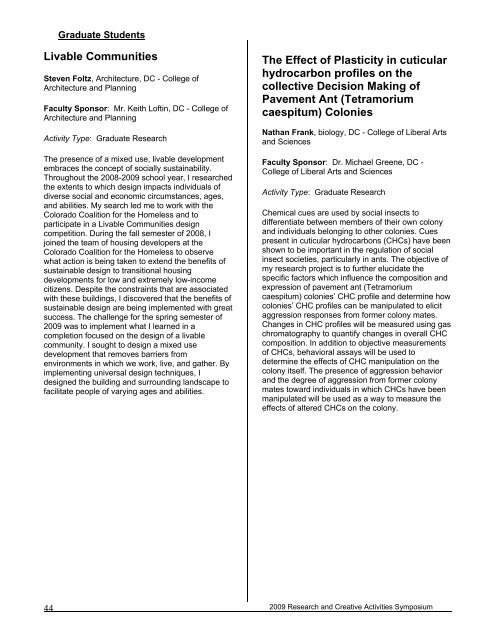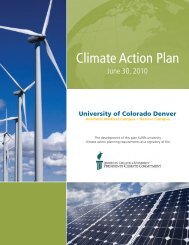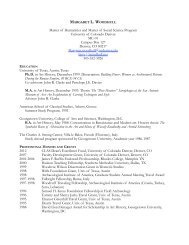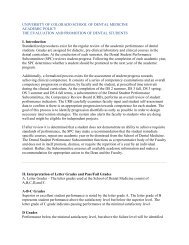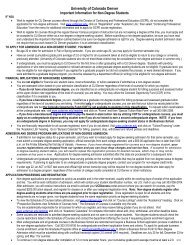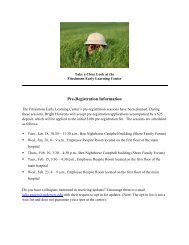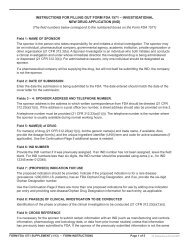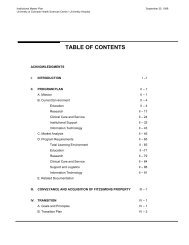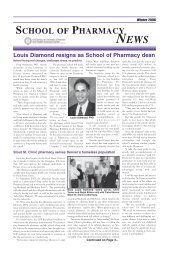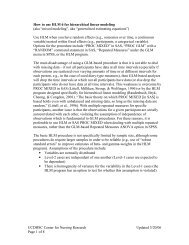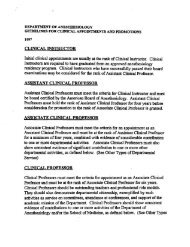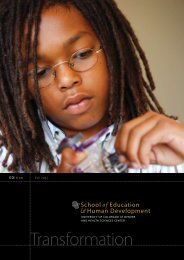2009 Proceedings - University of Colorado Denver
2009 Proceedings - University of Colorado Denver
2009 Proceedings - University of Colorado Denver
You also want an ePaper? Increase the reach of your titles
YUMPU automatically turns print PDFs into web optimized ePapers that Google loves.
Graduate Students<br />
Livable Communities<br />
Steven Foltz, Architecture, DC - College <strong>of</strong><br />
Architecture and Planning<br />
Faculty Sponsor: Mr. Keith L<strong>of</strong>tin, DC - College <strong>of</strong><br />
Architecture and Planning<br />
Activity Type: Graduate Research<br />
The presence <strong>of</strong> a mixed use, livable development<br />
embraces the concept <strong>of</strong> socially sustainability.<br />
Throughout the 2008-<strong>2009</strong> school year, I researched<br />
the extents to which design impacts individuals <strong>of</strong><br />
diverse social and economic circumstances, ages,<br />
and abilities. My search led me to work with the<br />
<strong>Colorado</strong> Coalition for the Homeless and to<br />
participate in a Livable Communities design<br />
competition. During the fall semester <strong>of</strong> 2008, I<br />
joined the team <strong>of</strong> housing developers at the<br />
<strong>Colorado</strong> Coalition for the Homeless to observe<br />
what action is being taken to extend the benefits <strong>of</strong><br />
sustainable design to transitional housing<br />
developments for low and extremely low-income<br />
citizens. Despite the constraints that are associated<br />
with these buildings, I discovered that the benefits <strong>of</strong><br />
sustainable design are being implemented with great<br />
success. The challenge for the spring semester <strong>of</strong><br />
<strong>2009</strong> was to implement what I learned in a<br />
completion focused on the design <strong>of</strong> a livable<br />
community. I sought to design a mixed use<br />
development that removes barriers from<br />
environments in which we work, live, and gather. By<br />
implementing universal design techniques, I<br />
designed the building and surrounding landscape to<br />
facilitate people <strong>of</strong> varying ages and abilities.<br />
The Effect <strong>of</strong> Plasticity in cuticular<br />
hydrocarbon pr<strong>of</strong>iles on the<br />
collective Decision Making <strong>of</strong><br />
Pavement Ant (Tetramorium<br />
caespitum) Colonies<br />
Nathan Frank, biology, DC - College <strong>of</strong> Liberal Arts<br />
and Sciences<br />
Faculty Sponsor: Dr. Michael Greene, DC -<br />
College <strong>of</strong> Liberal Arts and Sciences<br />
Activity Type: Graduate Research<br />
Chemical cues are used by social insects to<br />
differentiate between members <strong>of</strong> their own colony<br />
and individuals belonging to other colonies. Cues<br />
present in cuticular hydrocarbons (CHCs) have been<br />
shown to be important in the regulation <strong>of</strong> social<br />
insect societies, particularly in ants. The objective <strong>of</strong><br />
my research project is to further elucidate the<br />
specific factors which influence the composition and<br />
expression <strong>of</strong> pavement ant (Tetramorium<br />
caespitum) colonies’ CHC pr<strong>of</strong>ile and determine how<br />
colonies’ CHC pr<strong>of</strong>iles can be manipulated to elicit<br />
aggression responses from former colony mates.<br />
Changes in CHC pr<strong>of</strong>iles will be measured using gas<br />
chromatography to quantify changes in overall CHC<br />
composition. In addition to objective measurements<br />
<strong>of</strong> CHCs, behavioral assays will be used to<br />
determine the effects <strong>of</strong> CHC manipulation on the<br />
colony itself. The presence <strong>of</strong> aggression behavior<br />
and the degree <strong>of</strong> aggression from former colony<br />
mates toward individuals in which CHCs have been<br />
manipulated will be used as a way to measure the<br />
effects <strong>of</strong> altered CHCs on the colony.<br />
44<br />
<strong>2009</strong> Research and Creative Activities Symposium


